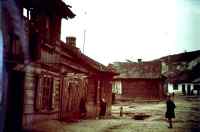 |
| Izbica Transit-Ghetto # 1 |
Although
Aktion Reinhard was organized mainly against the Jews
living in the
Generalgouvernement, people from Germany, Austria,
Böhmen und Mähren, and
Slovakia were among the victims as well.
From
March until June 1942 around 27,000 Jews from abroad
were deported to Izbica (17,000 persons),
Piaski (5,000 persons) and Rejowiec (5,000 persons). Transit ghettos (organized by the headquarters
of
Aktion Reinhard) were also installed in
Opole Lubelskie, Deblin,
Zamosc, Chelm, Wlodawa, and
Miedzyrzec Podlaski.
All these places were located close to the main railway lines heading for
Belzec and
Sobibor (
Miedzyrzec Podlaski on the
way to
Treblinka).
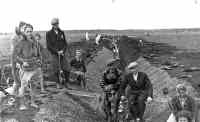 |
| Sawin: Work for WWI |
According to several testimonies by survivors and Polish witnesses, deportees were sure that the
purpose of the deportations was sending them for work somewhere in the East. Therefore, in many cases
they asked the local inhabitants for the allocated factories in which they had to work. Even when they
were already in the transit ghettos, nobody knew about the existence of death camps. Most of them were
elderly along with women and children. In many instances, young men, still capable of working were
selected from these transports in
Lublin and sent to the
Majdanek concentration camp. In the transit ghettos
there was no work for the deportees (the
Lublin district was never
industrial). Only a small number of
people were sent from Izbica to
Augustowka and
Bzite, two small forced labour camps of
the
Wasserwirtschaftsinspektion (
WWI).
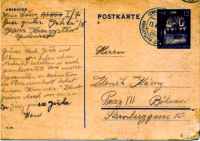 |
| Postcard from Izbica #1* |
The condition of life in these small provincial Polish towns was very primitive (lack of water and food,
old and mostly wooden houses, demolished during the deportations of their owners to the death camps). These places
were not prepared to absorb thousands of people at any given time. Therefore the ghettos were overcrowded
(10 - 20 persons per room) with many starving and dying of malnutrition. The situation in Izbica
(
Photo of Ghetto Houses) or Piaski
(one of the towns having a closed ghetto) can be compared with the
Warsaw Ghetto, but in a micro scale.
Among the deportees were many doctors, but there was no real possibility in helping people due to the
lack of hospitals and drugs. In the memoirs of the witnesses from Izbica there is mention of many victims
succumbing to the typhus epidemic. The conditions in Izbica, Piaski and Rejowiec can be described as
vestibules for the death camps.
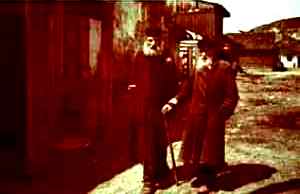 |
| Izbica Transit-Ghetto # 2 |
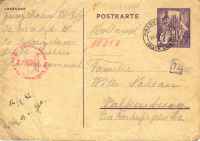 |
| Postcard from Izbica #2 |
Very early on, most of the deportees lost contact with their relatives and friends back home. According
to a special order by the
RSHA (
Reichssicherheitshauptamt) from
end of May 1942, they were not
even allowed to send letters to areas outside the
Lublin district. The
prohibition of correspondence
combined with lack of contacts to Polish Jews and local Poles (language barrier and cultural differences
with Polish Jews) caused a deep conflict between themselves and Polish Jewry who were
resistant to difficult life conditions. For Jews from the west, conditions in the transit-ghettos
were a culture shock from which their letters home conveyed. The conflict between Polish and foreign
Jews was used by the SS to organize more effective deportations. Very often German and Czech Jews,
speaking German fluently, were members of the
Judenrat (see e.g. the
Judenrat in Piaski) and Jewish police in the ghettos. In Izbica
for example, the local
Gestapo chief and local mayor had his own private Jewish police squad,
recruited from Czech Jews. These men participated in the round-ups. Especially in Izbica, Jewish
policemen from western countries selected mainly Polish Jews for deportation. On the other hand
policemen being recruited from Polish Jews rounded up mainly Jews from the West.
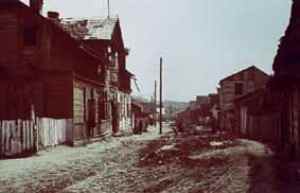 |
| Izbica Transit-Ghetto # 3 |
In the Izbica transit ghetto, double Jewish institutions were installed: two
Judenräte (one for the
Polish Jews, the other for those from the West), two committees of social welfare and two Jewish police units.
Izbica was the largest transit ghetto located between
Belzec and
Sobibor. Except from German, Czech,
Austrian and Slovakian Jews, about 4,000 Jews from
Zamosc and some groups
of Polish Jews from nearby small towns and villages in
Krasnystaw
county were relocated to Izbica during the final phase of the ghetto liquidations in the
Lublin district. The Izbica Ghetto was not closed because its location in the
valley, surrounded by hills and a river, facilitated the separation of the victims.
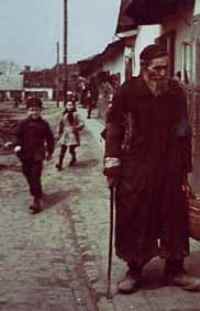 |
| Izbica Transit-Ghetto # 4 |
Piaski and Rejowiec were concentration sites too for Polish Jews. Exact information regarding the number
of victims having gone through these ghettos is not available.
According to testimonies, the SS killed around 2,000 Jewish victims in the course of Izbica's last execution
(early November 1942) at the local
Jewish cemetery. Before the extermination, people had to spend several
days in the overcrowded
fire-station building.
Many died from lack of fresh air or water. In Piaski 1,000 - 2,000 persons were executed during the
final liquidation of the ghetto. In Rejowiec, hundreds were killed on the market square and on their way
to the railway station when the ghetto was liquidated.
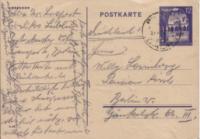 |
| Postcards from Piaski |
The exact death camp, to which people were sent, is nearly impossible to pinpoint. Transports could be
sent from Izbica
to
Belzec or
Sobibor. According to
testimonies and literature the first two deportations
from Izbica (on
24 March 1942 and
8 April 1942) were sent to
Belzec. Most of these victims were
Polish Jews. They were deported due to the SS requiring space for deportees from western countries.
The transport of
14 - 15 May 1942, during which German and Czech Jews were rounded up,
went to
Sobibor and
Majdanek (young men, fit for
work were sent to this camp) other deportations were sent to
Belzec and
Sobibor.
Research should be carried out regarding the camp in
Trawniki. It was not only a work camp but also a transit camp for many
1942 transports. Many were deported to
Sobibor from
Trawniki.
Photos: Edward Victor
*
Sources:
State Archive in Lublin:
The Records of the Governor in Lublin District
Jewish Historical Institute in Warsaw:
Records of the Jüdische Soziale Selbsthilfe in
Izbica and Krasnystaw. Memoirs and testimonies by survivors
Private Collection of Robert Kuwalek:
Testimonies by Kurt Thomas, Thomas Blatt and the
Interviews with Polish Witnesses from Izbica
T. Berenstein:
Martyrologia, opor i zaglada ludnosci zydowskiej w dystrykcie lubelskim.
"Biuletyn Zydowskiego Instytutu Historycznego", No. 21 (1957)
T. T. Blatt:
Sobibor. The Forgotten Revolt. A Survivor's Report. Issaquah 1998
T. T. Blatt:
Nur die Schatten bleiben. Der Aufstand im Vernichtungslager Sobibor. Berlin 2000
A. Hindls:
Einer kehrte zurück. Bericht eines Deportieren. Stuttgart 1965
R. Kuwalek:
Getta tranzytowe w dystykcie lubelskim (Izbica, Piaski, Rejowiec, Trawniki).
Lecture for the International Conference "Aktion Reinhardt".
The Annihilation of the Jews in Generalgouvernement. Lublin 2002
L. Swietlicki:
Piaski we wspomnieniach. Piaski 2000
















